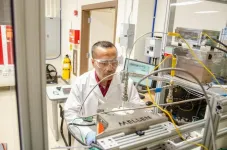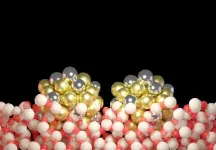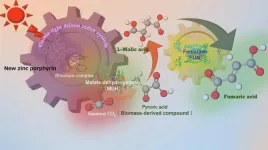(Press-News.org) West Virginia University engineers have secured $3 million in U.S. Department of Energy funding to research a new chemical reactor system that uses microwaves to reduce industrial heat and carbon emissions.
The first-of-its-kind technology would allow industrial facilities to simultaneously produce ethylene and ammonia, two chemicals that contribute significantly to greenhouse gas emissions, within a single microwave reactor. That device uses heat from microwave electromagnetic radiation to carry out chemical reactions.
The carbon-negative process would reduce energy consumption by 85%.
Lead researcher John Hu is the Statler Chair in Engineering for Natural Gas Utilization at the WVU Benjamin M. Statler College of Engineering and Mineral Resources, a professor of chemical engineering and director of the WVU Center for Innovation in Gas Research and Utilization. Hu emphasized that, while the study focuses on ethylene and ammonia production, the technology can be broadly applied to many other industrial processes that need heat to work.
Various industries need heat to do everything from removing moisture and creating steam to melting plastics and treating metals. According to the DOE, industrial heat accounts for approximately 9% of U.S. emissions. The heat used in conventional industrial processes is typically produced through carbon-intensive methods like combustion. When that heat transfers through different materials like reactor walls, coils and catalysts, it loses energy in the process, undermining sustainability as well as efficiency.
Hu explained that because the microwave reactor can start up and shut down within minutes, it can draw on intermittent sources of renewable energy for power. A traditional reactor requires steady, reliable energy sources and cannot run on renewables like solar or wind energy.
“Using microwaves allows us to control the heat delivery very precisely, so that we can quickly switch between heating the reactor to produce methane and cooling it to synthesize ammonia,” Hu said. “By using the hydrogen from methane coupling, we remove the need for a hydrogen production step in ammonia synthesis and make the process much more friendly to the environment.”
Also contributing to the research are WVU assistant professors Yuxin Wang and Yuhe Tian, and Srinivas Palanki, professor and chair of the Statler College Department of Chemical and Biomedical Engineering.
Their work builds on existing WVU patents and research demonstrating microwave reactors operate at significantly lower temperatures than traditional methods for industrial heating and produce fewer undesirable byproducts. The approach enables operation of the reactor in “non-equilibrium mode,” which increases efficiency and improves product yields.
Hu said the technology is “precise, allowing us to vary the power and frequency of the microwave pulses over time, rapidly switching between high and low temperatures. To optimize operations, we’re incorporating machine learning that processes real-time data obtained from measurement tools inside the reactor.”
The reactor design has been validated in the laboratory, and Hu said his goal is a successful demonstration within a real-world industrial environment by the end of the three-year study.
Once the reactor technology is commercialized, job creation will follow, Hu said, especially in regions like West Virginia with “stranded” natural gas resources that currently aren’t feasible for use. Companies will need workers to produce and process ethylene and move it along the supply chain, which is why Hu’s team will consult with local communities, particularly those negatively affected by the coal economy, about how the development of low-carbon ethylene and ammonia industries could benefit them.
The researchers will also start building a qualified local workforce through engagement with K-12 students and teachers and WVU students. WVU undergraduates will collaborate on the research through the University’s Research Apprenticeship Program, Summer Undergraduate Research Experience and Experiential Learning Program. Both undergraduate and graduate students will also participate in research exchanges with Clemson University, which has partnered with WVU on the study, and pursue internships with the National Energy Technology Laboratory and Dow.
“Our research is part of a larger industrial transformation,” Hu said. “By next year, the U.S. will have 3.5 million jobs to fill in science, technology, engineering and mathematics fields. To spark interest in these lucrative fields even before college, we’ll host experiences for high school students and teachers in our labs and build activities around this research that will be the basis for WVU Engineering Challenge Camps, engaging local high school and middle school students.”
In addition to Clemson, NETL and Dow, participating organizations include the University of South Carolina and West Virginia State University.
END
WVU close to commercializing microwave technology that can cool down industry’s energy usage
2024-02-16
ELSE PRESS RELEASES FROM THIS DATE:
New Issue of GEN Biotechnology
2024-02-16
GEN Biotechnology announces the publication of its February 2024 issue. GEN Biotechnology publishes outstanding peer-reviewed research and perspectives in all aspects of biotechnology. The Journal, led by Editor-in-Chief Hana El-Samad, PhD (UCSF; Altos Labs) and Executive Editor Kevin Davies, PhD, is published bimonthly in print and online.
For full-text copies of articles or to arrange interviews with Dr. El-Samad, Dr. Davies, authors, or members of the editorial board, contact Kathryn Ryan at the Publisher.
1. Original Research: ...
New chip opens door to AI computing at light speed
2024-02-16
Penn Engineers have developed a new chip that uses light waves, rather than electricity, to perform the complex math essential to training AI. The chip has the potential to radically accelerate the processing speed of computers while also reducing their energy consumption.
The silicon-photonic (SiPh) chip’s design is the first to bring together Benjamin Franklin Medal Laureate and H. Nedwill Ramsey Professor Nader Engheta’s pioneering research in manipulating materials at the nanoscale to perform mathematical computations using light ...
Study shows impact of antidepressants on fetal brain development during pregnancy
2024-02-16
A new study published in Nature Communications provides direct evidence that antidepressant use during pregnancy can impact a child’s brain development and contribute to the risk of mental health disorders later in life.
The study, led by researchers at the University of Colorado Anschutz Medical Campus, focused on the effect of fluoxetine, commonly used in medications such as Prozac and Sarafem for treating depression and perinatal depression, on a developing prefrontal cortex.
Since fluoxetine works by increasing the levels of serotonin in the brain, the researchers looked at the impact serotonin has on prefrontal ...
First human trial shows ‘wonder’ material can be developed safely
2024-02-16
A revolutionary nanomaterial with huge potential to tackle multiple global challenges could be developed further without acute risk to human health, research suggests.
Carefully controlled inhalation of a specific type of graphene – the world’s thinnest, super strong and super flexible material – has no short-term adverse effects on lung or cardiovascular function, the study shows.
The first controlled exposure clinical trial in people was carried out using thin, ultra-pure ...
Towards more efficient catalysts
2024-02-16
Researchers from the Harvard John A. Paulson School of Engineering and Applied Sciences (SEAS), Harvard Department of Chemistry & Chemical Biology, and Utrecht University have reported on a previously elusive way to improve the selectivity of catalytic reactions, adding a new method of increasing the efficacy of catalysts for a potentially wide range of applications in various industries including pharmaceuticals, cosmetics and much more.
The research is published in ...
Laboratory study on conditions for spontaneous excitation of "chorus emission," wave of space plasma
2024-02-16
A dipole magnetic field, created by a ring current, is the most fundamental type of magnetic field that is found both in laboratories and in space. Planetary magnetospheres, such as Jupiter's, effectively confine plasma. The RT-1 project aims to learn from nature and create a magnetosphere-type high-performance plasma to realize advanced fusion energy. Simultaneously, the artificial magnetosphere offers a means to experimentally understand the mechanisms of natural phenomena in a simplified and controlled ...
Advanced artificial photosynthesis catalyst uses CO2 more efficiently to create biodegradable plastics
2024-02-16
Amid growing global concern over climate change and plastic pollution, researchers at Osaka Metropolitan University are making great strides in the sustainable production of fumaric acid – a component of biodegradable plastics such as polybutylene succinate, which is commonly used for food packaging. The researchers have managed to efficiently produce fumaric acid, which is traditionally derived from petroleum, using renewable resources, carbon dioxide, and biomass-derived compounds.
In a previous study, a research team led by Professor Yutaka Amao of the Research Center for Artificial Photosynthesis at ...
Mystery solved: the oldest fossil reptile from the alps is an historical forgery
2024-02-16
A 280-million-year-old fossil that has baffled researchers for decades has been shown to be, in part, a forgery following new examination of the remnants.
The discovery has led the team led by Dr Valentina Rossi of University College Cork, Ireland (UCC) to urge caution in how the fossil is used in future research.
Tridentinosaurus antiquus was discovered in the Italian alps in 1931 and was thought to be an important specimen for understanding early reptile evolution.
Its body outline, appearing dark against the surrounding rock, was initially interpreted ...
The ties that bind
2024-02-15
Trace metals are nutrient elements, like zinc, that animals and plants need in small amounts to function properly. Animals generally get trace metals in their diets or through environmental exposures, while plants take their trace minerals up from soil. If we get too little, we may experience a deficiency, but the opposite can also be true: too much of a trace metal can be toxic.
Scientists believe that up to 50% of the trace metals in soils and urban environments may be bound to the surfaces of mineral grains — rendering the trace metals ...
New GSA publication addresses dementia care in adults with I/DD
2024-02-15
Addressing Brain Health in Adults With Intellectual Disabilities and Developmental Disabilities: A Companion to the KAER Toolkit for Primary Care Providers is a new publication from the Gerontological Society of America (GSA) designed to address the needs of adults with intellectual and developmental disabilities (I/DD) who develop dementia.
Freely available at geron.org/brainhealth, this companion document:
Raises awareness of unique needs of adults living with I/DD.
Equips and encourages caregivers and health care teams to engage in ...







